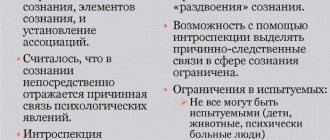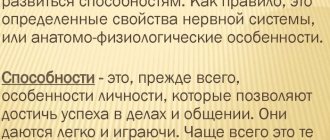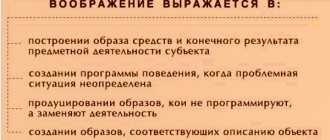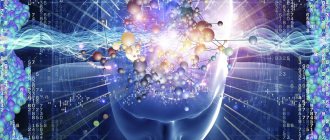Definition of the term “ability” in psychology
In psychology, abilities are properties of the human psyche, determined by the special development of functional organs and psychological structures, which allow him to master new knowledge, skills and abilities in a specific field of activity with particular speed and success.
For people who have certain abilities (in a specific field of activity), the speed of mastering new knowledge and skills is several times higher than the effectiveness of development in this area for those people who do not have such abilities.
For example, if a child has mathematical abilities (ease of arithmetic calculations, good memory, pronounced logical thinking), it is much easier for him to study mathematics and solve complex problems, unlike a child who does not have these abilities.
To successfully master and carry out different types of activities, different abilities are required. The speed and quality of acquiring new knowledge, skills and abilities in the relevant field of activity depends on them.
Origin of abilities and their structure
There are 2 theories of the origin of human abilities. The theory of the emergence of abilities through the transfer of genetic information from parent to child and the theory of the development of abilities as a result of training, upbringing and the influence of the external social environment on a person.
The genetic theory of the emergence of abilities is based on well-known facts, when the children of outstanding scientists or artists also became scientists or achieved success in the relevant field of art. For example, a very common occurrence was the discovery of appropriate musical abilities in children of musicians (Mozart, Haydn).
Another striking example is the emergence of a whole dynasty of musicians and composers among the descendants of the famous great composer Johann Sebastian Bach.
The theory of the emergence of abilities under the influence of training and factors of external social influence is based on a number of experiments that confirm the development of almost any abilities, in the case of correct and systematic training of a person by experienced teachers, as well as as a result of proper upbringing in early childhood, when the main anatomical and physiological components are formed child's psyche.
As a result of the coexistence of these theories, modern psychology accepts them equally. The formation of abilities is influenced by both heredity and environmental factors, which can compensate for the lack of any innate abilities or, on the contrary, suspend their development.
The basic structure of abilities (in a general sense) consists of the following parts:
- Information part (knowledge about the world and society, scientific knowledge, knowledge about ways to carry out certain actions in various types of activities).
- The psychophysical part (experience in carrying out certain actions in the field of activity being mastered, expressed in specific skills and abilities).
- The creative part (the ability and willingness to find new types of solutions to any problems, the ability to create more effective skills and abilities).
- The emotional part (the ability to form positive emotions in relation to the activity being carried out, the ability to use emotions to more effectively master skills).
The presence of the above elements in the structure of abilities allows a person to effectively develop his abilities in any field of activity.
The development of individual elements of the ability structure affects the overall progress of the development of the ability itself, which in turn leads to a further strengthening of the development of its individual parts. Thus, the development of an ability is a mutual cyclical process involving the ability itself and its individual parts.
The structure of the ability of any specific activity, in addition to the general structure, will include a number of additional qualities that a person performing this activity must have.
For example, the structure of abilities that a person engaged in musical activity must have includes such elements as a sense of rhythm, an ear for music, and musical memory.
With regard to literary activity, in addition to the general structure of abilities, it should include such additional elements as clear functioning of the speech apparatus, a developed sense of aesthetics, the need for self-expression and fantasy.
Each specific type of activity has its own structure of abilities. A person carrying out any type of activity must have the appropriate abilities.
What are the abilities?
The structure of abilities is largely determined by the specific area of activity in which a person’s strengths are most clearly manifested. In this regard, the following typology is distinguished:
- mental - the ability to quickly and efficiently resolve issues that arise before an individual;
- musical abilities determine the presence of hearing, voice, good sensitivity to tempo, rhythm and melody, as well as quick comprehension of the basics of playing certain instruments;
- Literary is the ability to fully, expressively and beautifully express one’s thoughts in writing;
- technical abilities imply good combinatorial thinking, as well as a deep understanding of the operation of certain mechanisms;
- physical - imply a strong physique and developed muscles, as well as good endurance and other parameters;
- learning abilities imply the ability to perceive and understand large amounts of information with the possibility of their further practical application;
- artistic skills are the ability to perceive and convey proportions and colors, as well as create original forms, etc.
It is worth noting that this is not a complete list of abilities that a person may have.
Inclinations are the natural basis of abilities
Abilities are, in psychology, personality traits that determine the speed and quality of mastering knowledge, skills and abilities. The initial form of future abilities are inclinations, which are hereditary anatomical and physiological characteristics of the body, which can manifest themselves in the form of the following properties of the nervous system:
- Special perception of artistic forms, sounds or colors (the ability to recognize or analyze them, quickly memorize or reproduce them).
- High sensitivity of the nervous system.
- The pursuit of knowledge, high activity in public relations.
- Good memory and logical thinking, ability to analyze or generalize.
The difference between inclinations and abilities is that they are not specific and cannot specifically relate to any one activity or to any particular ability. The same inclinations can be used in the formation of different abilities in different fields of activity.
For example, excellent eyesight and innate attentiveness can become part of the abilities of an artist or professional archer. Different types of activities require certain abilities, which in turn can be based on the inclinations they require.
The makings of the visual system can be used in activities that require good vision (fine arts, sports). The inclinations of the speech apparatus can be successfully used in a field that requires a high level of its development (oratory, linguistics).
Inclinations are the basic “bricks” on which a person’s abilities and all professional activities are built. They begin to appear in preschool and early school age. During this period, the functional development of areas of the brain responsible for the coordination of the organs of movement, the logic of thinking, as well as the improvement of various analyzers occurs:
- vision;
- hearing;
- touch.
The discovered inclinations in the child must be developed in relation to the area of activity that interests him. As a result, the formation of abilities will take place more effectively and meet the necessary requirements of this activity.
Basic provisions of the theory of abilities
Modern psychological science identifies several provisions on which the theory of abilities is based:
- Abilities can exist only in relation to a certain type of activity. The structure and development of abilities can be identified and studied only in relation to a specific area, and not in general.
- Capabilities are considered to be a dynamic concept. They can develop in the process of continuous or regular performance of any activity, and can also fade away if the active stage has ended.
- The structure of a person’s abilities largely depends on the age or life period in which he is located. Thus, at certain times, favorable conditions may arise to achieve maximum results. After this, the abilities may gradually disappear.
- Psychologists still cannot give a clear definition of the differences between abilities and giftedness. Speaking in general terms, the first concept relates to a specific type of activity. As for giftedness, it can be both specific and general.
- Any activity requires a set of certain characteristics. The structure of abilities ensures the success of its implementation.
What are tendencies?
When a person develops an interest in a particular type of activity, and he strives to develop his inclinations in this direction, then this initial orientation of the individual is called an inclination.
In the process of mastering the chosen direction of development, an inclination can develop into an ability. If a person changes his interests in the process of mastering the chosen direction, then other inclinations may appear, which can be further developed to the corresponding abilities or remain without further development.
Levels of ability development
Abilities are, in psychology, personality traits that affect a person’s ability to master the necessary skills and abilities in a certain field of activity.
Ability development consists of the following 3 levels:
- Determination and development of inclinations.
- Determination and development of inclinations.
- Development of abilities.
As a result of research into the development of human abilities, it has become clear that different abilities appear at different age periods during early childhood. For example, at the age of 2-4 years a child develops the ability to learn speech. At 5-6 years old the ability to read appears. At primary and secondary school age, the child exhibits aptitude for creative development.
If the child is not helped in developing the appropriate basic abilities at the right times, this may negatively affect his further development. These moments in ontogenetic development are called sensitive periods.
For the successful development of abilities, the factor of the external social environment and the quality of education play a huge role. The presence of inclinations and inclinations in itself cannot form the necessary abilities in a person.
The formation of specific abilities occurs as a result of a targeted learning process by teachers or parents (if they are competent in the relevant field of activity).
In addition to the environmental factor, the effectiveness of developing abilities also depends on the factor of the person’s personal activity. A correctly developed attitude towards your chosen work activity and the formation of interest in it allows you to achieve success more effectively.
It is very important at an early stage of a child’s development to interest him as much as possible in the activities for which he shows inclinations and inclinations during this period.
If a person in childhood develops the ability to self-organize and have a personal interest in the development of any abilities, then in the future it will be easier for him to navigate the world and achieve the necessary success in achieving his goals.
Classification of abilities
The classification structure of abilities can be described as follows:
- In accordance with origin: natural abilities have a biological structure and are determined by the development of innate inclinations;
- social abilities - those that were acquired in the process of upbringing and training.
- general abilities are necessary due to the fact that they have a wide scope of application;
- potential abilities manifest themselves over time after exposure to certain conditions;
- giftedness;
Conditions for the formation of abilities
The foundation for the emergence and development of abilities are the neuromuscular functional organs, which are formed in a child from birth to 6 years. In a healthy child, all physiological elements (hearing, speech, nervous system, thinking) allow the full development of both basic and special abilities.
When teaching children, an important condition for the effective development of abilities is their comprehensive development. Some abilities are closely related to others (speech is related to hearing, vision is related to thinking). The development of just one ability in isolation from others is unacceptable.
For the comprehensive development of a child it is necessary:
- provide a creative approach to learning;
- create interest in the subject of study;
- create a positive emotional mood;
- provide the necessary degree of complexity of tasks in relation to the abilities being mastered.
A creative approach to business forms independent thinking in a child, as a result of which he can:
- find new solutions to assigned problems;
- analyze your actions;
- adjust them, improving your capabilities.
During training, it is necessary to ensure that the tasks assigned to the child are sufficiently difficult. They should not be too complex: if they are unfulfilled, this may hinder the development of appropriate abilities.
If the tasks and the activities corresponding to them are too simple, then this will also not lead to the proper development of abilities, but will only ensure their functioning at the current level.
In the process of activities that develop the child’s abilities, his emotional mood plays a significant role in the development of new skills and abilities.
When certain positive results are achieved in a child’s activities aimed at developing his specific abilities, it is necessary to take care of the emotional reinforcement of each of his successes, since failures also arise in the process of activity, which, against the backdrop of successes, should not cause a negative attitude of the child towards the activity he is performing.
How to find them in yourself
Some people, being at a fairly mature age, say that they do not have any abilities or even the makings of them. This is fundamentally wrong, since everyone has them , it’s just that not everyone realizes and develops them.
How to find your abilities when it seems that “nature has rested on you”? It is necessary to do research work, which consists of three steps:
- Take a blank sheet of paper, a pen and write down all your dreams that you have had from the moment you remember yourself to the present day. Write absolutely everything, leaving nothing out. This step may take an hour, or a day. Write until you are sure that you really remember everything.
- Then select from this list those items where we are talking about what you wanted to do , who to work (we eliminate the dream of traveling to Africa to scratch the belly of a crocodile).
- Read the remaining paragraphs one by one. Take your time, listen to yourself , to your feelings after reading each one.
For example, you wanted to be a veterinarian. Remember what you did while dreaming about it? Maybe the yard cats were “treated” and the neighbors’ dogs were walked? What emotions do you have now when you remember? Perhaps you feel a surge of energy and a desire to immediately go to school or open a veterinary clinic. Or maybe you understand that this profession no longer resonates in your soul. You are far from animals in principle, and this activity does not attract you in any way. So, let's cross it out. - Having sorted the wheat from the chaff, you will be left with a very small list of what really generates a powerful positive response within you. These are your inclinations that need to be developed . How to do it? Read on.
Abilities and Individual Differences
If you teach several people the same abilities, they will still differ from each other:
- characters;
- the degree of mastery of these abilities;
- the presence of other abilities and inclinations.
Individual differences between people are determined by their inclinations, which can be either congenital or acquired.
The speed and efficiency of development of the corresponding abilities depends on the severity of certain inclinations. Congenital inclinations are the foundation for certain abilities, which in turn can be the inclinations for abilities of a higher order.
For example, in order to begin studying higher mathematics, you must first master elementary mathematics, which will act as a prerequisite for its study.
Different people have different sets of inclinations and corresponding abilities. Thus, as a result of their development and interaction with other people in the social environment, their individual differences arise.
conclusions
Abilities are specific properties of a person that determine his propensity to perform a particular type of activity. They are not innate. This category includes inclinations, the presence of which greatly facilitates the process of developing abilities. Also, this concept should not be confused with giftedness or talent.
Psychologists identify several features that characterize the structure of a person’s abilities. They distinguish people from each other, and also determine their achievement of success in a particular field of activity. It is a mistake to believe that abilities are hereditary; this can only be said about inclinations. In addition, they cannot arise independently if a person is not engaged in a certain kind of activity. If there is no development, then the abilities gradually weaken and disappear (but this does not mean that they cannot be restored).
Depending on the field of activity, abilities are of several types. Thus, mental ones allow you to quickly respond to changes in the situation, making meaningful and rational decisions. If we talk about musical abilities, then this is the presence of hearing and voice, perception of tempo-rhythm, as well as easy mastery of playing musical instruments. Literary ones are manifested in the ability to beautifully formulate one’s thoughts, and technical ones - in an understanding of the functional features of certain mechanisms. Speaking about physical abilities, it is worth noting endurance, as well as developed muscles. Educational ones make it possible to perceive and reproduce large amounts of information, and artistic ones make it possible to convey colors and proportions. This is a basic, but far from complete list of human abilities.
Abilities and aptitudes
A person’s abilities develop in accordance with his inclinations, which represent a manifestation of interest in a particular activity. The emerging inclinations encourage a person to develop the abilities corresponding to them. As a rule, tendencies begin to appear in early childhood.
There are individual and general inclinations. Individual inclinations, for example, include a child’s desire to study music, painting or technical sciences.
Common inclinations that arise in almost all children, for example, include a tendency towards manual labor. The development of this type of work is very important at a child’s early age, as it contributes to his mental development, forms and strengthens his ability to work, and also develops creative thinking.
It is very important to distinguish true inclinations from the desire for any activity for profit or as a result of its imposition on a person by other people. If the inclinations do not cause genuine love for the work, but are dictated only by the goal of success, the development of abilities in this case may be too difficult or impossible.
Conversely, true interest and love for a chosen activity or profession will lead to the full development of abilities corresponding to this activity.
Ability Theories:
- According to the structural approach, abilities are basic concepts, units of analysis, elements of structure. Inclinations determine the area of opportunities for developing abilities. They manifest themselves in activity. B.M. Teplov noted that there is a direct connection between inclinations (absolute ear for music) and subject specificity.
- The functional approach (personal) considers ability as a functional formation that appeared in connection with the solution of a life personal problem. For example, if the subject is motivated to become a musician, then hearing can be formed (pseudo-absolute pitch). Abilities are formed and developed in activity by transforming other natural inclinations.
Abilities and giftedness
Abilities are, in psychology, the individual psychological qualities of a person that allow him to effectively master new knowledge, skills and abilities in a certain field of activity.
The presence of different abilities in different people distinguishes them from each other, but some people have such abilities that allow them to achieve results above and beyond the similar abilities of other people. Such people are called gifted.
Typically, giftedness manifests itself from early childhood, and giftedness in various areas of activity manifests itself at a certain time. For example, giftedness in the arts (music, drawing) manifests itself earlier than giftedness in the sciences.
Being gifted does not mean that a child will become an artist or mathematician on his own. The development of the abilities of children (with any level of inclination) largely depends on environmental factors, the quality of education and upbringing.
Basic signs of abilities
The category of abilities is of quite great interest. The structure of the concept includes three main features:
- individual characteristics of a psychological nature, which serve as a distinctive feature that sets an individual apart from other people;
- the presence of abilities determines success in performing an activity of a certain type (in some cases, in order to perform actions at the proper level, the presence, or, on the contrary, the absence, of certain characteristics is required);
- These are not direct skills and abilities, but individual characteristics that determine their acquisition.
Types of abilities, examples
People's abilities come in different types, which differ from each other in the nature of the activity associated with them and its content.
Creative abilities of the individual
Creative abilities include those human abilities that allow him to create something new, both in the material and social spheres of society.
Thanks to the presence of these abilities in an individual, he has the opportunity to find previously unknown, more effective solutions to existing problems, create new ideas and achieve his goals using ingenuity and extraordinary thinking.
Creativity may include the following elements:
| Ability | Advanced Feature |
| Ability to find the cause of a problem | In the process of studying any issue or problem, be able to find and analyze information that goes beyond the scope of this issue or problem. |
| Ability to generate new ideas | Apply new ideas in the process of professional activity. |
| Think original and flexible | When solving assigned problems, use information from different classes of phenomena and sources. |
| Ability to improve already known methods of ongoing activities | Combine different methods to solve problems more effectively. |
| Ability to critically evaluate one's actions | Analyze the results of the work and find shortcomings yourself. |
The creative abilities of the individual are used in almost all areas of activity (music, painting, science).
Individual abilities of the individual
There are types of abilities that distinguish some people from others. Individual abilities can be of varying degrees of severity. The ability to combine multiple abilities and perform complex activities as efficiently as possible is called giftedness.
The ability to create something new, original and easily solve problems of increased difficulty is called talent. If the result of activity is masterpieces of world significance, then in this case there is a genius of the individual.
Social abilities of the individual
As a result of communication with people, an individual develops abilities that meet the rules of behavior and certain social norms. Social abilities include the ability to work in a team, the ability to manage people, and the ability to resolve various social conflicts.
In the process of social education, an individual develops such social qualities as:
- leadership;
- altruism;
- honesty;
- discipline;
- respect for people and society.
Professional abilities of the individual
Professional abilities are divided into two types: general and special. General professional abilities are those properties of an individual that are necessary to perform a certain type of activity and are determined by the subject of work in the profession:
- Human;
- nature;
- technique;
- artistic image.
Special professional abilities are determined by a specific profession, the narrow specialization of which requires special professional skills.
Personal communication abilities
A person’s communication skills help him interact correctly and effectively with people. If these abilities are well developed, it is easy for a person to find a common language with people around him, as well as achieve success in business relationships and business.
Intellectual abilities of the individual
Depending on how rich a person’s accumulated experience of intellectual and professional activity is, the degree of his intellectual abilities is determined.
The development of these abilities occurs due to the expansion of a person’s horizons and the acquisition of experience in various types of activities. Thanks to these abilities, a person can think and reason abstractly and logically, use spatial imagination, and also effectively use knowledge from various fields of activity in solving assigned problems.
By developing his abilities, a person can improve the quality of his life, as well as influence the state of the external social environment and the living conditions of other people. Knowledge about the organization and capabilities of these properties in psychology allows people to consciously and purposefully develop and enrich their knowledge, which is one of the main criteria for achieving success in life and the development of society as a whole.
Author: workenter
List of abilities
- academic
- analytical
- artistic
- verbal
- Gnostic
- deductive
- didactic
- diplomatic
- inventive
- intellectual
- research
- cognitive
- communicative
- constructive
- creative
- linguistic
- mathematical
- mental
- mnemonic
- musical
- oratorical
- organizational
- pedagogical
- perceptual
- educational
- entrepreneurial
- prognostic
- psychophysical
- sensory
- suggestive
- creative
- telekinetic
- technical
- mental
- managerial
- physical
- artistic
- empathic
- aesthetic











